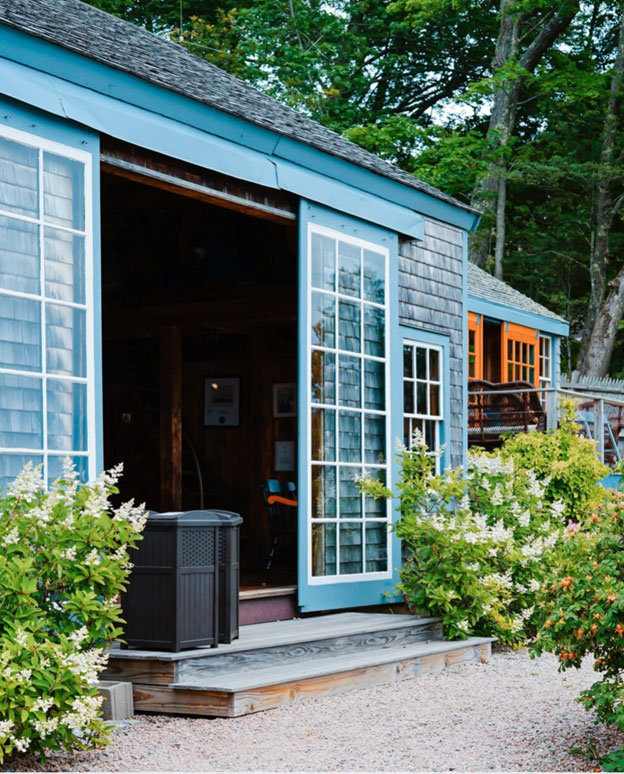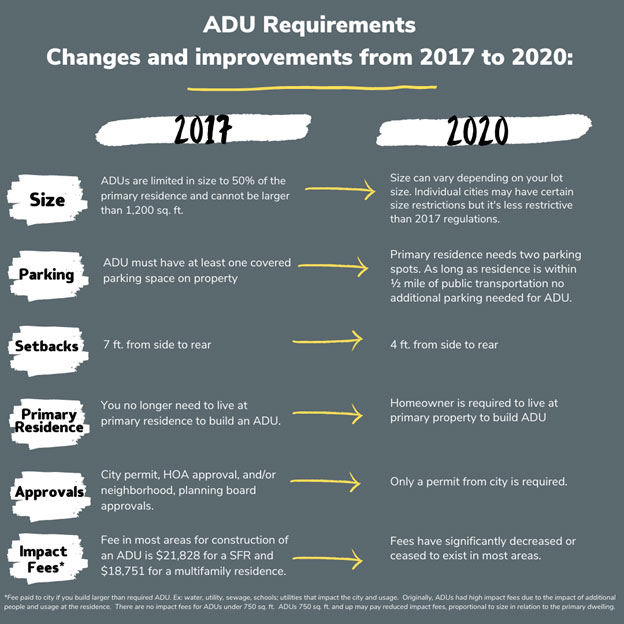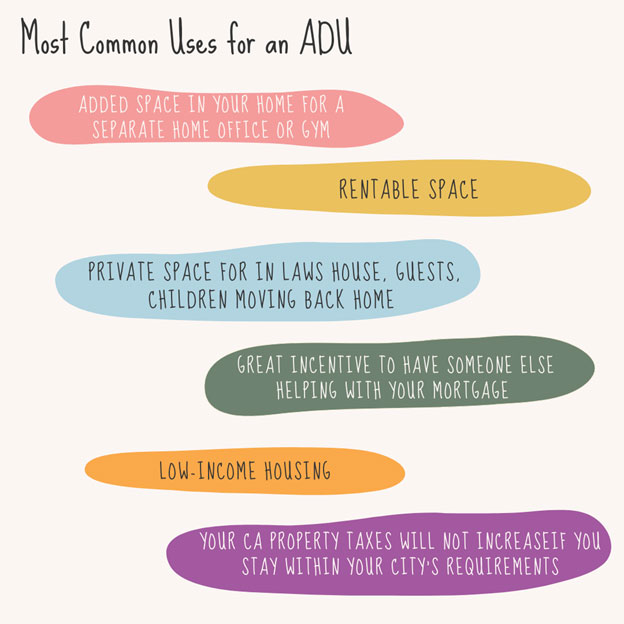ADUs; what you don’t know could cost you!
Have you thought about adding one but are not sure where to start?
Get started on the right track here.
Deborah and Gulshen:
We interviewed Kristen Flores, Construction Program Manager and Principal of Flo Engineering, who specializes in helping people navigate the ADU build process, to give us the details of what it takes to build an ADU in Southern California.
Kristen informed us that whatever you thought about ADUs in the past to ignore that. They are worth it and worth looking into!

Photo credit: Flo Engineering Inc.
DnG: ADUs are a hot topic right now. Homeowners want extra income and, people working from home need more space. Tell us what an ADU is and why it might be beneficial to build one?
Kristen: An accessory dwelling unit (ADU) is a smaller, independent housing unit located on the same lot as an existing residence and is an affordable type of housing unit to build in California. ADUs can be considered the next revolutionary add to a homeowner’s property, as they increase property value, supply affordable housing, provide additional housing for family or guests, and provide additional income to homeowners. For a building to be considered an ADU it must contain a kitchen or kitchenette, living area, plumbing/sanitation, and a separate entrance. The square footage of an ADU can vary and there are size restrictions based on what city you live in and the size of your lot.
DnG: Can you give us a little history about the creation of ADUs in California and what has recently changed?
Kristen: ADUs were approved in June 2017 when the state of California declared it was in a housing crisis and needed a solution. Officials got creative and started thinking of ways to build more affordable housing in our state; and the ADU was created and approved. Back then, building an ADU was much more restrictive and not as affordable. Also, cities were not accommodating to help homeowners get started.
A big improvement from the ADU requirements in 2017, was an added discussion about how to best incentivize homeowners to want to build an ADU. Over 70% of households in California are at max living capacity with 2 to 3 people in their homes. As of January 2020, many of the original ADU restrictions have been lifted, making these units more attractive to homeowners. Mostly due in part to the severe housing shortage in the state, which forced the federal government to give the state monetary incentives to encourage homeowners to build ADUs. Los Angeles was deemed one of the counties in California with the greatest housing shortage. The government is now incentivizing cities to encourage homeowners to build ADUs to help with the housing shortage in our state.
DnG: What are some of the new incentives?
Kristen: It has taken almost three years for cities to understand how best to incentivize homeowners and for homeowners to realize that building an ADU is a profitable venture and worth it. Grants include: LEAP Grants, REAP Grants, and SB 2 Planning Grants.
For investors who want to build an ADU and flip houses, incentives have also been added. For example, there are companies like Rent the Backyard where you sell a portion of your property, and a company comes in to build the ADU. You are basically renting your backyard to a company who builds the ADU.

Want to know more about the 2020 changes?
8 Things to Know About California’s 2020 ADU rule changes

DnG: What is the biggest hurdle for people considering an ADU?
Kristen: Homeowners have been apprehensive to consider an ADU because they typically do not know where to begin. There are many considerations: Do I call the city I live in first to get approval and are there any requirements? Should I call a company like Flo Engineering to get an estimate of costs and determine whether it makes sense to build an ADU on my property? Do I need an architect? Where can I put an ADU and how big can it be? Are there any loans available or any restrictions if I want to rent it out? Can it be used as a vacation rental?
Another problem we run into is people get overly zealous and tend to want to overbuild their ADU, which can end up decreasing the value of your property. Our goal is to find a perfect fit for your ADU that adds value to your property.
Where you can place your ADU is relative to the city and specifically the HCD [Housing and Community Development Department] representative I communicate with regarding each project. One of the benefits of using a rep like myself, is that I can get creative with a homeowner’s permit request, so the likelihood of it passing is greater.
DnG: Who should a homeowner call first if they want to build an ADU?
Kristen: Before you call anyone, you should write down the reasons you want to build an ADU, how it will affect where you currently live (if you live in the primary dwelling), where you want to put it, how big you think you want it and other critical requirements. Make a list of questions you have, so you are prepared and can get the most realistic answers before you begin. Many people who contact their local city first might be dissuaded to build an ADU and end up getting denied if they do not have all the necessary info or if the city is backlogged with other projects. Making your first call to a company like ours, can save you a ton of time and money trying to figure it all out for yourself, and ultimately avoid making missteps. That way, your dream of building an ADU becomes a reality much quicker.
There are many facets of this project that homeowners do not often think of. Our goal is to help the homeowner navigate the often-confusing process of envisioning, resourcing, and building an ADU on their property. We do all the legwork and research ahead of time to provide you with the information needed to determine if building an ADU, and what type of ADU, is right for you. We provide the ideal team and resources when it comes to the construction of your ADU. You want someone who understands the intricacies of ADUs and how to achieve this project effectively and efficiently.
DnG: What is the process like if a homeowner chooses to meet with an engineering firm like yours?
Kristen: The first thing I do is sit down with my clients to determine what their objective is for building an ADU. Is it to expand your current living space by adding a gym or an office? Or maybe you need additional living space for a young adult who recently graduated from college or aging in-laws who you want to live closer to you. The most common reason people build ADUs is to create additional income for themselves by renting out the unit.
Once that is determined, we will devise a plan for the client. We are also very knowledgeable about financing and can provide loan options as well. For example, if a client’s intention is to rent out the ADU to low-income residents, there are programs available that you would want to take advantage of, such as the LA ADU Accelerator Program or the CalHome program, Affordable Housing Trust Funds. If your intention is to build a back office or in-law suite, then we can help you decipher between a HELOC (Home Equity Line of Credit: always preferred, reassures that you do not build more than the equity in your property) and a construction loan. You would definitely want to take advantage of these programs to save money.
Once the ADU intention is determined, we will discuss design. Do you want a studio, one-bedroom or 2-bedroom unit? How many square feet do you want or need, and so on, to determine the best fit.
From there we start the process of hiring the necessary people to start your project. Based on our knowledge and extensive network, we lock arms with our clients to decide which contractors, engineers, designers are best to begin and finish each project.
DnG: Are there any hidden issues or concerns that people often do not think of when decided to build an ADU?
Kristen: Yes! ADUs can get very costly if you didn’t factor in having to add water lines or power lines for instance. Or if you need a soils engineer because you live on a hillside or in a sandy area. Do you need an architect to draft plans or will a draftsman suffice? Often, we need to determine if excavation is necessary; can we fit a bobcat in to remove dirt, and what are the cost implications?
We can do all this research ahead of time, so you are fully aware of all the costs before you begin. Why take it on yourself? Save yourself the grief and have someone knowledgeable guide you through the process.
One thing to note. ADU regulations are subject to change regarding the regulations around the California housing crisis.
If you would like to know more about ADUs, please refer to the reference sites below. And – always check with your local municipality for ADU specifications.
California Department of Housing and Community Development:
FAQs about ADUs:
http://caladu.org/ordinance/FAQsADUs.pdf
California’s New Accessory Dwelling Units Laws: What You Should Know
FLO Engineering Inc.
Contact Kristen directly for more information on ADUs and the various sizes and requirements for California.

